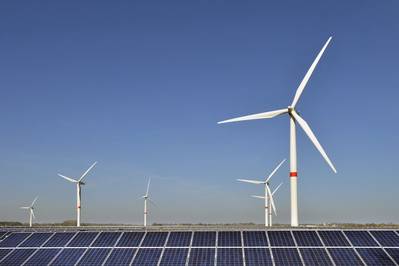German Renewable Targets Create Grid Challenges
Germany must build new power transmission lines if it wants to nearly double its renewable energy share by 2030 - a challenge given that grid expansion is already behind target, the head of the federal network regulator said on Tuesday.
"There is a simple correlation, the more volatile renewables there are, the more the grids will have to be expanded," said Jochen Homann, president of the Bundesnetzagentur, responsible for keeping the lights on in Europe's biggest economy.
Germany aims to raise wind and solar power's energy share from a third now to 65 percent by 2030 to help cut carbon dioxide emissions and achieve its climate commitments, in line with the wishes of the new coalition government.
Before these goals were set, the Bundesnetzagentur or Federal Network Agency had made plans based on a renewable share of 47.5-52.5 percent by 2030, Homann told a news conference.
"Now we're dealing with significantly more," he said.
Germany is set to quit nuclear power by 2023, losing 11,000 megawatts (MW) of reliable capacity between 2016 and then.
While Germany's renewable power capacity of around 100,000 MW can theoretically meet 100 percent of demand under favourable weather conditions, the problem is that, if the weather turns, there can be next to no green power.
Bundesnetzagentur data show that of some 5,900 kms (3,700 miles) of additional grids and power line improvements planned to accommodate the rise of renewable installations in the next decade, only 450 km have been approved and 150 km have been implemented.
The picture for plans up to 2020 is a bit more favourable.
Power network operators overseen by the authority expect that around 80 percent of the 1,800 km of new lines due to be completed by that date can be achieved.
Even if digitalisation meant that existing networks could be better tapped, as unused resources could be better allocated, "this must not come at the expense of security," Homann said.
Transmission grid firms, dependent on weather patterns, reduce or add power capacity to grids to keep supply stable.
Costs for such measures have been exploding due to the volatile nature of renewables, posing a burden for consumers, who share these as part of their final bills.
Last year should have seen another rise to above 1 billion euros ($1.19 billion) in these so-called "re-dispatch" costs, after 2016 was below and those in 2015 above that figure, Homann said.
To ensure grid stability next winter, the authority said last week it foresees network reserve needs of 6,600 MW, well down from 10,400 MW in the winter just past.
This is because Germany's and Austria's power market zones will be split from October 2018, allowing for lower costs and fewer technical risks in cross-border power flows.
($1 = 0.8418 euros)
(Reporting by Vera Eckert, editing by Adrian Croft)











